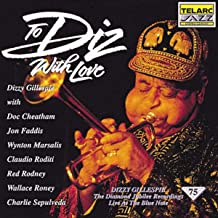
Requisites
To Diz With Love ~ Dizzy Gillespie | By Eddie Carter
For this morning’s choice from the library, I’ve chosen a CD-album to honor a true pioneer. John Birks Gillespie, known throughout the world by his nickname Dizzy was a renowned bandleader, composer, singer, teacher, and trumpet player. He, alongside Charlie Parker, changed the face of jazz forever by creating and becoming the inspirational voice of Bebop. At the time of this CD-album’s release in October 1992, he was celebrating his 75th Birthday. The folks at Telarc Jazz recognized this significant achievement with their first release performed earlier in the year at The Blue Note in New York City. Forty-seven shows in all were recorded by Telarc over an entire month resulting in one of the best live albums that year. To Diz With Love (Telarc Jazz CD-83307) also features the talents of Doc Cheatham, Jon Faddis (track: 3), Wynton Marsalis (tracks: 2 & 4), Claudio Roditi, Wallace Roney (tracks: 1 & 5), and Charlie Sepulveda (track: 4) on trumpet, Red Rodney (track: 2) on fluegelhorn, Junior Mance on piano, Peter Washington on bass, and Kenny Washington on drums.
The opener, Billie’s Bounce by Charlie Parker was composed in 1945 and dedicated to Gillespie’s agent, trumpet player, Billy Shaw. Shaw was also the inspiration for Gillespie’s composition, Shaw ‘Nuff, written a year later. The ensemble starts this standard with a vivacious introduction by the rhythm section that grows into a rapid run of the opening chorus led by the front line. Claudio kicks off this uptempo cooker with a high-energy drive that builds its emotional level enthusiastically. Wallace produces a very hot flame of exhilarating verses on the second solo. Dizzy takes the next statement for a sizzling uptempo ride. Then, Junior takes charge, swinging with an intense and passionate feeling on the fourth interpretation. Peter keeps the ingredients stirring on the next performance with a soulful groove, and Kenny wraps up the solos with a fierce attack on the finale preceding the closing chorus and climax.
Parker’s Confirmation, written in 1946 adds Marsalis on trumpet and Rodney on flugelhorn to join Dizzy. The rhythm section provides a medium beat for the horns to strut comfortably during the melody. Marsalis solos first with full-toned ease at a relaxing momentum. Dizzy is up next using the mute to offer an endearing whispery reading. Rodney follows with a subtle tone and cool modality that winks to “Bird”. The front line provides a few more statements, then Mance delivers a soft, dreamy solo preceding the climax. Up next is Mood Indigo by Duke Ellington, Barney Bigard, and Irving Mills featuring Cheatham and Jon Faddis. It was written in 1930 for a radio broadcast and originally titled Dreamy Blues. The public went wild after hearing it, Mills renamed the song Mood Indigo and wrote the lyrics for it. Doc leads off the solos with a profoundly sensitive statement. Jon conveys an emotional impact on the next reading and Dizzy delivers the blues with subtle elegance. Junior expresses delight in a brief statement before the ensemble wraps it up.
Thelonious Monk’s Straight, No Chaser was written in 1951 and is given a spirited treatment with Marsalis and Sepulveda as the featured soloists. Wynton starts swiftly on the lead solo with phenomenal energy, then Charlie burns strongly on the next scintillating statement. Dizzy shows the depth of his intensity on the third interpretation, followed by Junior who says a mouthful on the next reading. Peter provides some powerful brushwork on the closing statement.
A Night In Tunisia is Gillespie’s signature and most famous tune. It was written in 1942 and opens with an invigorating theme by the ensemble collectively. Claudio is ablaze right from the start of the first interpretation. Dizzy lights an intense fire on the second solo, then Wallace responds with a torrid reading that burns fiercely. Junior embarks on an aggressive performance that’s executed beautifully. Kenny puts the final stamp on the standard with a fierce groove on the drums. The treat though, comes at the end when during the closing chorus, Dizzy brings Lew Soloff up from the audience to lead the group into the song’s conclusion.
Telarc has created a sonic masterpiece that’s a joy to listen to by engineers Jack Renner (one of the founders of the iconic label) and Michael Bishop. To Diz With Love is not just a celebration, but an exceptional musical performance by one of the undisputed masters of Bebop. It’s also the first of three final Gillespie performances recorded before his passing and is highly recommended for any jazz fan’s collection. The other two releases are To Bird With Love, and Bird Songs: The Final Recordings!
~Bird Songs: The Final Recordings (Telarc Jazz CD-83421); To Bird With Love (Telarc Jazz CD-83316) – Source: Discogs.com ~ Billie’s Bounce – source: JazzStandards.com ~ Mood Indigo – source: Wikipedia.org © 2020 by Edward Thomas Carter
More Posts: choice,classic,collectible,collector,history,instrumental,jazz,music,trumpet


